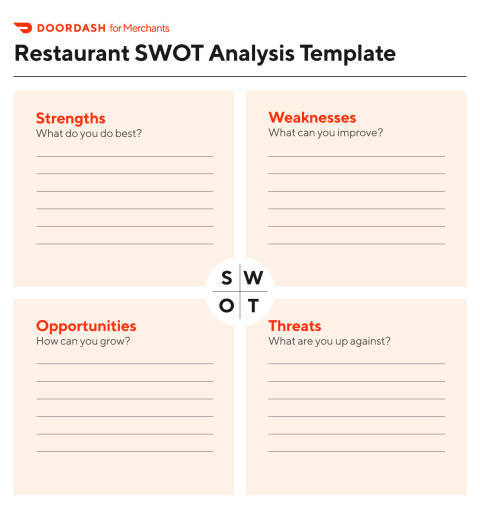If you're building a business plan for a new restaurant or looking to revamp your current one, conducting a SWOT analysis for your restaurant is a straightforward and efficient method to evaluate your market standing and create a growth strategy for your business.
What is a SWOT analysis?
A SWOT analysis is a framework for strategic planning and the acronym stands for the four aspects of the business that this tool evaluates: Strengths, Weaknesses, Opportunities, and Threats. It's not just about knowing your internal operations and the external environment — it's about identifying the intersections where you can transform weaknesses into strengths and threats into opportunities.
As a restaurant owner, this involves looking at the internal aspects you can control, while also recognizing the opportunities or threats from external elements that could impact your business. An illuminating SWOT analysis can inform new marketing and menu strategies, and inspire new processes to give you a competitive advantage.
Performing a SWOT analysis for your restaurant will help you pinpoint your market position, shape your unique brand or concept, and identify growth opportunities. Given the constant evolution of consumer tastes, established restaurants should undertake a SWOT analysis annually.

Strengths: What does your restaurant do best?
Begin by spotlighting what your restaurant does best: What sets your eatery apart from the competition? What keeps regulars coming back for more? Here are a few strengths to consider:
Brand reputation: Your restaurant's robust and positive reputation attracts new customers and keeps regulars returning.
Unique offerings: A signature dish, standout atmosphere, or type of cuisine differentiates your restaurant and draws in clientele.
Strong customer loyalty: Loyalty programs, outstanding customer service, and consistent quality foster a steady business flow.
Advanced technology: Leveraging technology enhances operations, customer experience, and provides valuable data insights — setting your restaurant apart.
Financial resources: Adequate financial backing smooths operations and supports expansion and resilience during economic downturns.
Weaknesses: What does your restaurant need to improve?
Focus on areas where you recognize your operations or offerings could use some enhancement. No restaurant is perfect — so taking a look at your weaknesses is vital for growth. Ask yourself these questions:
High operating costs: Is your restaurant spending too much on supplies, labor, or utilities?
Poor brand perception: Are you addressing customer issues head-on and improving your restaurant's public perception?
Dependence on specific markets/customer base: Do you need to diversify your target audience and explore new markets because of slow growth?
Outdated technology/equipment: Is your technology slowing down service, decreasing food quality, and affecting overall efficiency?
Employee skill gaps: Do you need to invest in regular training and development opportunities to ensure your team meets your restaurant's standards?
Opportunities: What can your restaurant do to grow and thrive?
Explore ways to enhance your restaurant's sales and profit margins, and consider leveraging new industry trends and consumer habits. Identify who your customers are and understand their evolving dining preferences. Here are some examples:
Expansion: Consider the potential of opening new locations or using third-party delivery to reach more customers.
Upgraded technology: Implementing an online ordering system can streamline operations and improve customer experience.
Menu/product/services diversification: Introducing new menu items or services like delivery and catering can help attract a broader audience.
Changing consumer preferences: Accommodate dietary choices by adapting your menu to include health-conscious, plant-based, keto-friendly, gluten-free, or customizable options.
Partnerships: Collaborate with local businesses or food producers to offer unique dishes and promote community engagement.
Sustainability initiatives: Implement eco-friendly practices such as reducing waste, sourcing local ingredients, or updating your to-go packaging.
Threats: What challenges can impact your restaurant?
Finally, consider the competitive environment and the broader economic and cultural influences that might pose risks to your business's success. These could include:
Economic downturns: If the overall economy is lagging or performing poorly, this could lead to reduced consumer spending.
Increasing competition: As new restaurants and food delivery services proliferate, consider ways you can differentiate your offerings and stand out in the market.
Supply chain disruptions: Whether caused by seasonal, political, or production issues, disruptions can increase costs and impact customer satisfaction.
Market saturation: Too many restaurants targeting the same customer base can make attracting and retaining patrons challenging.
Changes in consumer behavior: Shifts towards healthier eating or an increasing preference for online delivery can spur restaurants to adapt their offerings or operations.

Why is a SWOT analysis important for your restaurant?
A SWOT analysis for restaurants uncovers opportunities for targeted marketing campaigns, timely menu updates, and operational enhancements — and paves the way for strategic reassessment. Identifying the most significant opportunities and threats through a SWOT analysis helps you stay ahead in the competitive food industry landscape, thereby strengthening your business for the long term. Apply what you learn to help improve your restaurant's profit margins, better the overall customer experience, maintain employee satisfaction, and give you an edge over the competition.
How to run a restaurant SWOT analysis
Let's explore the steps to effectively running a SWOT analysis for your restaurant. This process should involve collaboration with your team. Talk to both front and back of the house employees to get a well-rounded perspective of your business. Here are some steps to get you started:
Investigate your restaurant's current state: Review financial reports, operations, sales data, and customer feedback to gain deeper insight into all facets of your business.
Gather data to support your analysis: Metrics such as restaurant and customer reviews, delivery ratings, social media engagement, and qualitative experiences from diners and staff also offer invaluable perspectives.
Know your peers: Network extensively with restaurateurs and industry insiders to learn how your peers are faring, and visit competitor restaurants to learn more about their menu offerings, quality of service, and types of customers. You can also glean important information about competitors' marketing strategies by following their social media accounts and subscribing to their email lists.
Conduct team surveys or brainstorming sessions: Your employees see your operation from various angles every day, and they can reveal insights that may not be immediately obvious. Sending an email survey or hosting a brainstorm focused on a specific issue can give you a better understanding of your daily operations.
Restaurant SWOT analysis template
Here is our free sample template for conducting your restaurant SWOT analysis.

Gather more restaurant insights with DoorDash
A SWOT analysis is one tool to give you insight into your business's performance and potential, but a deeper dive can give you even more of a competitive edge. Whether your goal is to introduce delivery and pickup options, launch your personalized online ordering site, partner with a white-label delivery service, offer catering and group ordering, or venture into virtual restaurants, DoorDash provides a suite of solutions to help your restaurant flourish.





